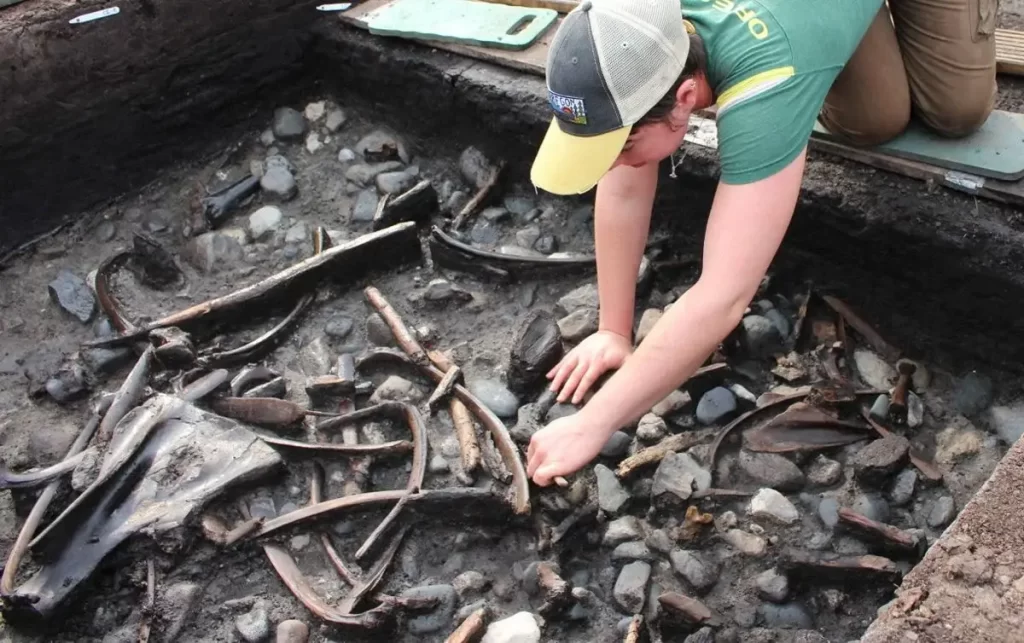Archaeologists from the University of Chester have uncovered a remarkable Mesolithic-era hunter-gatherer settlement near Scarborough, England. This discovery offers an extraordinary glimpse into the lives of prehistoric people who inhabited the region thousands of years ago. The settlement was originally situated on the shores of an island within an ancient lake, but over the millennia, the site became buried beneath thick layers of peat, which helped preserve its artifacts and organic remains.

The excavation has yielded an astonishing array of discoveries, including animal remains that indicate the species hunted by these ancient people, as well as tools and weapons fashioned from bone and antler. Perhaps even more remarkable are the rare traces of woodworking found at the site, which provide evidence of sophisticated craftsmanship and resource utilization.
Dr. Nick Overton from The University of Manchester emphasized the rarity of finding such well-preserved materials from this period. “It is so rare to find material this old in such good condition. The Mesolithic in Britain predates the introduction of pottery or metalworking, which means that organic remains like bone, antler, and wood are usually lost to decay. However, in this case, the exceptional preservation has allowed us to gain invaluable insights into the daily lives and practices of these early inhabitants.”
A detailed analysis of the animal bones has revealed that the Mesolithic hunters targeted a variety of species, including elk, red deer, beavers, and water birds. The remains indicate that these animals were butchered, and certain parts were deliberately placed in the wetlands surrounding the settlement. This careful deposition suggests that these early hunter-gatherers engaged in ritualistic practices related to the hunting and processing of their prey.
Among the recovered artifacts, several bone and antler weapons stand out due to their intricate decorations. Interestingly, these weapons appear to have been dismantled before being placed in the wetlands, reinforcing the idea that the inhabitants followed a structured set of rituals regarding animal remains and hunting tools. Such practices suggest that the act of hunting and the subsequent treatment of remains were deeply significant, possibly imbued with spiritual or cultural meaning.
Dr. Amy Gray Jones from the University of Chester highlighted the significance of these findings in reshaping common perceptions of prehistoric hunter-gatherers. “Many people imagine prehistoric hunter-gatherers as constantly struggling to find food, moving from place to place in a desperate search for sustenance. However, the evidence from this site tells a different story. These people were not merely surviving—they were thriving within a well-understood landscape rich in resources.”
Rather than living in a state of perpetual hardship, the Mesolithic inhabitants of this settlement appear to have had an intimate knowledge of their environment. They understood the behaviors and habitats of various animal species, allowing them to hunt effectively and manage resources in a sustainable manner. This level of confidence in their surroundings challenges the notion that a settled and stable way of life only began with the advent of farming.
The presence of decorated objects further supports the idea that these people had the time and cultural inclination to engage in artistic expression. The care with which they disposed of animal remains and important artifacts also suggests a structured belief system, where certain rituals and traditions played a key role in their daily lives.
The site near Scarborough provides a crucial window into the world of Mesolithic Britain. Unlike later periods where pottery and metal tools became common, these early people relied on organic materials, which rarely survive in the archaeological record. The exceptional preservation at this site, however, has allowed researchers to uncover a wealth of information about their way of life, beliefs, and customs.
Furthermore, the location of the settlement—on the shores of an ancient lake—suggests that access to water played a fundamental role in their choice of habitation. Wetland environments are known to provide abundant food sources, including fish, waterfowl, and plant materials, making them ideal locations for hunter-gatherer communities. The presence of well-preserved woodworking traces also indicates that these people utilized timber for construction, tool-making, or other purposes, further demonstrating their adaptability and skill.
The findings challenge long-standing assumptions about the hardships of prehistoric life. Rather than being nomadic wanderers on the brink of starvation, the people who lived here had a deep understanding of their ecosystem, engaged in artistic expression, and followed intricate customs regarding their tools and hunting practices.
This discovery also raises important questions about the transition from hunting and gathering to farming. While agriculture eventually led to more permanent settlements, the evidence from this site suggests that some hunter-gatherer communities already lived relatively stable lives, with well-established traditions and a secure food supply. This indicates that the shift to farming may have been more gradual than previously thought, with some groups choosing to adopt agricultural practices while others continued their traditional ways of life.
As excavations continue, researchers hope to uncover even more details about how these Mesolithic people lived, what they believed, and how they interacted with their environment. Each artifact adds another piece to the puzzle, helping to paint a fuller picture of life in prehistoric Britain.
The discovery near Scarborough is a testament to the resilience, intelligence, and cultural depth of early hunter-gatherers. Far from the simplistic image of struggling for survival, these people demonstrated remarkable adaptability, craftsmanship, and a deep connection to their surroundings. Their story, preserved for thousands of years beneath layers of peat, continues to unfold, offering valuable insights into humanity’s distant past.





